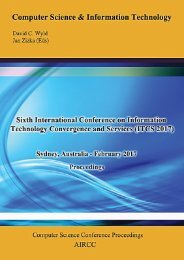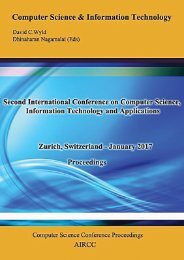CoSIT 2017
Fourth International Conference on Computer Science and Information Technology ( CoSIT 2017 ), Geneva, Switzerland - March 2017
Fourth International Conference on Computer Science and Information Technology ( CoSIT 2017 ), Geneva, Switzerland - March 2017
Create successful ePaper yourself
Turn your PDF publications into a flip-book with our unique Google optimized e-Paper software.
3.1. Architecture<br />
Computer Science & Information Technology (CS & IT) 117<br />
Figure 2 shows the architecture of the proposed approach, it is a learning to rank architecture. The<br />
approach is a mixture of models; it uses learning to rank to combine multiple features, and uses<br />
generative model (author topic model) to estimate the relation between author and query through<br />
unsupervised learning to link topics with document words and authors.<br />
3.2. Procedure<br />
Figure 2. Our Approach Architecture<br />
The input represents the topic of interest submitted by the user. The set of profiles belong to<br />
researchers where each profile contains personal information and the academic work done by the<br />
researcher, having the following attributes: name, affiliation, e-mail, location, homepage,<br />
summary about his career and a list of all his publications. These profiles are generated in [20]<br />
through correlating the information extracted from heterogeneous sources, by taking advantage of<br />
data repetition in multiple sources and those existing in one source. On one hand, data is being<br />
validated and links between sources are created. On the other hand, the missing data issue is<br />
solved, and are saved in the repository serving as the system’s internal input. The data manager is<br />
in charge of maintaining the training queries with relevance judgments of researchers with respect<br />
to those queries. Features are extracted based on the researchers’ profiles by the feature extractor,<br />
they are of two types; query-independent and query-dependent. The input into the learning system<br />
is the training instances. Each training instance refers to a query associated with feature vectors<br />
resulting from all features for researchers along with their relevance judgments with respect to<br />
that query. This component generates the learned ranking model, comprising of features’ weights,<br />
which serves as an input to the ranking system to handle all user-submitted queries. The ranking<br />
system receives the user’s input query, then retrieves the candidate experts from the set of all<br />
researchers. Afterwards, feature vectors for those candidates are built. Finally, the learned model<br />
is applied on the constructed feature vectors to generate a score for each candidate. The output<br />
displayed to the user is a ranked list of candidate experts by sorting the scores generated by the<br />
ranking system.





